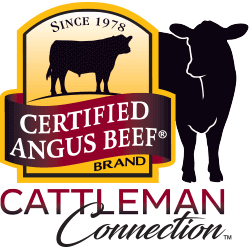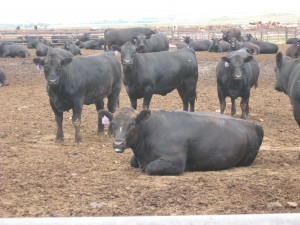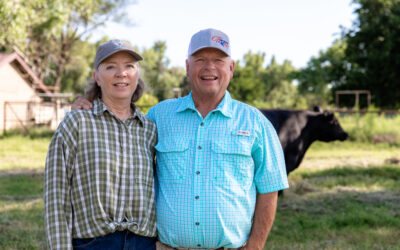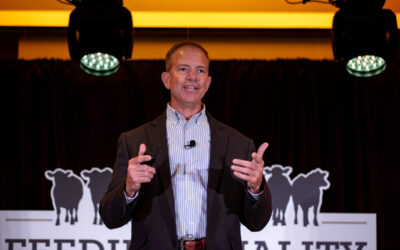
Tightening the belt!
Well, I’m going to take this story down a little different trail; but not that familiar route which is associated with cutting costs on the farm or ranch. Rather, I’m going to discuss tightening the genetic belt!
We’ve all seen many stories in agricultural press about the difference in value of a finished steer or heifer at slaughter; within a pen, that is. Which calves made the most money and which made the least money (or lost more money than the good ones). What still amazes me is the amount of variability in the final value of fat cattle within a common set of genetics, from the same operation! Size of the operation and pure numbers have a great deal to do with that; but when we’re seeing a value difference of $300 to $400 in the carcass due to hot carcass weight, carcass quality, or both, it still begs the question: “why?” Is it due to performance (ADG and F:G), or carcass premiums, dressed yield, or what? Maybe a combination of all these.
One of my first implant trials (in my previous life as an Extension specialist) on a group of commonly-sired Angus calves revealed a very tight-knit (or appeared to be) group of steers (75 head) that were within 50 lb. of each other; top to bottom, there was not more than half a hundred pounds among them all. I did not know the birth dates on the cattle; they may have been quite variable in age, but they didn’t look that way. They appeared to be very similar in frame size and were extremely close in live weight.
That 50 lb. weight diff turned into nearly a 300 lb. difference in finished weight at harvest. How can that be? For Pete’s sake, that just seemed huge to me! As we looked at individual average daily gain, it ranged from 2.75 to 3.75. Wow! Even a half a pound a day difference, on a 150 day feeding period, results in 75 extra pounds of live animal to sell when the cattle ship. In today’s dollars, that equates to a $90 per head difference in the gross income! Although we didn’t have individual feed efficiency measures to look at, one can imagine that some converted dry matter at 5.8 and some at 6.5. A feed:gain efficiency difference of 0.7 lb., or 2.1 lb. savings in $6.00 corn every day when assuming a 3.0 ADG would equal about 40 cents per head per day (at a DM ration cost of $ 375/ton). Over those same 150 days, that amounts to a feed (alone) cost savings of $60! Combine that with differences in grade (when sold on a grid), and we’re talking REAL BIG DOLLARS here!
This is why you need to take a hard look at GeneMax (GMX), Certified Angus Beef’s new DNA test for marbling and yearling gain. This cutting edge technology will allow you to do a couple of different things: (1) it can be used as a tool to help you determine which replacement heifers you are going to keep, in addition to other selection criteria (blood lines, feet and legs, phenotype, disposition, etc.) and (2) a predictor of feeder calves’ value in the fed cattle industry. If you can “tighten” down the amount of variability within a set of replacement heifers or feeder calves, it makes them more valuable. You have a better idea of what those calves can do! It’s not entirely full-proof; management, health, environment, and nutriton all affect the outcome. But I’ll guarantee you ONE thing: it’s more information than you used to get!
Take the time to peruse our website. Visit www.cabpartners.com and click on the GMX link. I really think you’ll be glad you did!
I was going to tighten my belt, and then I saw those peanut M&Ms!
~Gary
You may also like
Helping Hands, Helping Herds
“When I die, I want to come back as one of your cows,” murmurs a friend to Steve Zybach. Full to the brim from an alfalfa ration every day, bountiful fields of lovegrass stretched out across the Texas Panhandle—and owners who leave no ounce of cattle care up for question. The Zybachs’ motivation for this level of dedication to their Angus cattle is simply love.
System Over Scale
For Dallas Knobloch, it’s not about being the biggest feedyard—it’s about building a high-quality system that works. Today, with Tory’s wife Sadie and daughter Ivy, the Knobloch family owns and operates 4K Cattle. They feed 2,500 cattle at eight locations within 10 miles of home, manage 1,000 acres of crops and run a 125-head cow herd, all near Hills, Minn.
Data-Driven Progress and Partnerships
Discussions at Feeding Quality Forum reaffirmed the industry’s commitment to quality, transparency and innovation. With record Prime rates and strong consumer demand, producers who invest in genetics, health and relationships are positioned to drive progress and capture premiums.




